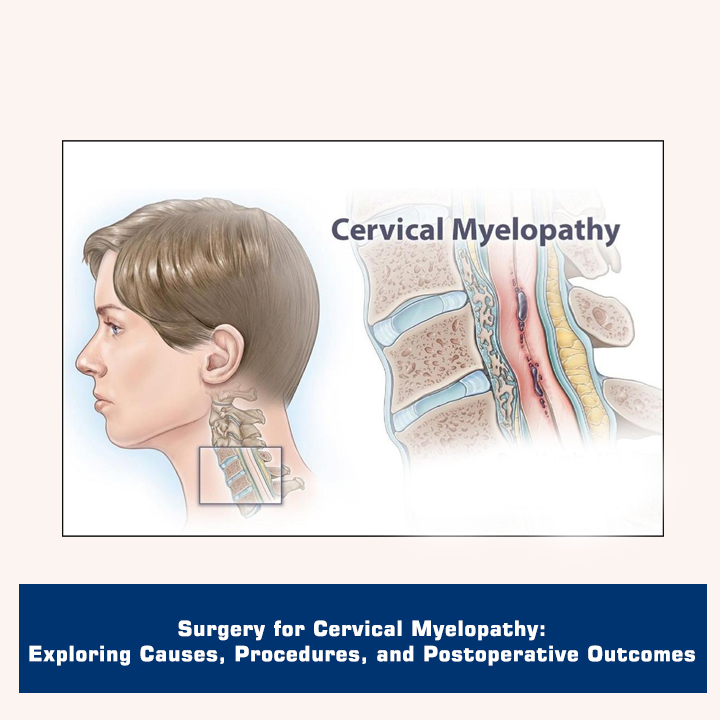


Introduction:
Cervical myelopathy is a condition characterized by compression of the spinal cord in the neck region, resulting in neurological symptoms. While conservative treatments are often attempted initially, surgical intervention becomes necessary in cases of severe compression or progressive symptoms. This article aims to provide a comprehensive guide to surgery for cervical myelopathy, including the causes, diagnostic procedures, indications for surgery, various surgical options, and postoperative outcomes.
Common Causes of Cervical Myelopathy
Cervical myelopathy can be caused by various factors, with the two primary causes being trauma and degenerative changes. Traumatic injuries, such as spinal fractures or dislocations, can result in compression of the spinal cord. Degenerative changes, including spinal stenosis, herniated discs, or bone spurs, can also lead to compression and subsequent myelopathy. Additionally, prolonged and improper use of mobile devices has been associated with an increased risk of developing cervical myelopathy.
Diagnosis of Cervical Myelopathy
Diagnosis of cervical myelopathy involves a thorough clinical evaluation, combined with imaging techniques such as MRI (Magnetic Resonance Imaging) and CT (Computed Tomography) scans. These imaging modalities help visualize the spinal cord, identify the presence of compression, and determine the extent of spinal stenosis or other structural abnormalities.
Indications for Surgery in Cervical Myelopathy Cases
Surgery is indicated in several situations, including the presence of progressive neurological deficits, significant weakness, signs of spinal instability, severe spinal cord compression, and failure of conservative treatments to alleviate symptoms. The decision for surgery is made on an individual basis, considering the patient's specific condition and response to nonsurgical approaches.
Various Surgical Options for Cervical Myelopathy
There are several surgical procedures available for cervical myelopathy, depending on the underlying cause and severity of the condition. Common procedures include spine fixation (instrumentation) to stabilize the spine, decompression to relieve pressure on the spinal cord, laminectomy or laminoplasty to create more space for the cord, and fusion to address instability or correct deformities.
Terms of Postoperative Outcomes
Postoperative outcomes for cervical myelopathy surgery are generally positive, especially when surgery is performed before the condition progresses too far. Successful surgery aims to relieve spinal cord compression, improve neurological function, and alleviate pain and other symptoms. However, the recovery process may vary among individuals and rehabilitation and physical therapy are often required to optimize outcomes.
Surgery Recommended in Cervical Myelopathy Cases
Early surgery is typically recommended in cases of cervical myelopathy to prevent further neurological damage and to achieve better postoperative outcomes. Delayed surgery may result in the progression of symptoms, irreversible neurological deficits, and increased risk of long-term sequelae. Early intervention allows for timely decompression and stabilization, avoiding potential complications and facilitating early mobilization.
Intraoperative Neuromonitoring Play in Cervical Myelopathy Surgery
Intraoperative Neuromonitoring involves the use of specialized techniques to monitor the function of the spinal cord and nerves during surgery. It provides real-time feedback to the surgeon, enabling them to make adjustments and minimize the risk of neurological complications. Neuromonitoring ensures the safety of delicate spinal structures during the procedure and helps preserve neurological function.
Conclusion:
Surgery for cervical myelopathy is a crucial intervention to address spinal cord compression and improve neurological function. Causes of cervical myelopathy can range from trauma to degenerative changes, and diagnosis is facilitated through imaging techniques such as MRI and CT scans. Surgical procedures, including spine fixation, decompression, and fusion, offer effective treatment options. Early surgery is recommended to avoid sequelae and facilitate early mobilization. Intraoperative Neuromonitoring plays a vital role in ensuring the safety of delicate structures during surgery. Individuals experiencing symptoms of cervical myelopathy should consult with a spine specialist to determine the most appropriate course of treatment.
